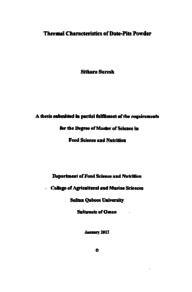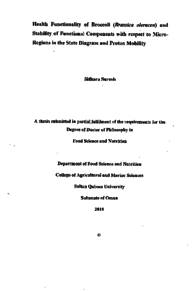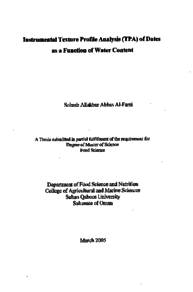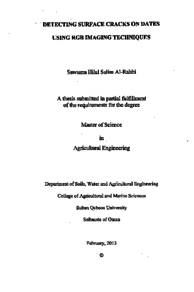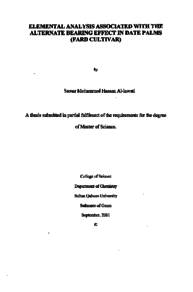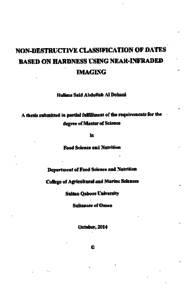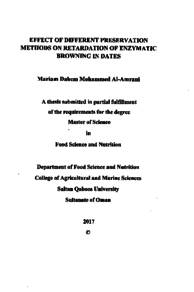Document
Thermal characteristics of date-pits powder.
Publisher
Sultan Qaboos University
Gregorian
2013
Language
English
Subject
English abstract
Date fruit plays a vital role in the economic and social lives of the people of Arab world. The date-pits are considered as a waste product from date fruit processing industry and it contains mainly complex carbohydrates and oil. The wide utilization of the date-pits powder requires understanding of its physico-chemical and structural characteristics. This thesis presents the studies of polyphenol contents, moisture sorption isotherm and thermal characteristics of date-pits. The polyphenol contents varied from 21-62 mg gallic acid equivalent/g date-pits when acetone, ethanol, methanol and water were used as extraction solvents at 22, 45, and 60 C. The measured moisture isotherm was modelled by BET and GAB models. The BET and GAB monolayer values of date-pits were estimated as 4.3 and 4.1 g/100 g dry-solids. BET monolayer indicated the amount of bound water to the specific polar sites, however GAB model could be used to predict the complete isotherm. The DSC thermogram of freeze-dried date-pits (moisture: 6.7 g/100 g date-pits) showed two endothermic peaks, a shift and an exothermic shift at high temperature after solids melting. The first endothermic peak was due to the melting of oil and the second one for solids-melting, while first shift indicated the glass transition and second exothermic shift after solids-melting was due to the interactions of melted solid components. At the heating rate 5°C/min, the melting peaks of oil and solids were observed at 2.7 and 197°C, respectively, and the exothermic shift was observed at 290°C. The melting peak temperature was decreased and melting enthalpy was increased with the increasing water content. The decrease of peak temperature could be due to the plasticization of solids with water and the increase of enthalpy could be due to the formation of hydrogen bond density requiring more energy. The peak temperature was modelled with Flory-Huggins model and the water-solids interaction parameter was estimated as 6.8x10'. Heating rate (5-100°C/min) and annealing condition were also used to explore the structural characteristics of the date-pits. The melting peak temperature increased exponentially with increasing heating rate and the data was fitted with Mehl-Johnson-Avrami and Kissinger models. The activation energy was observed as 5.6x10", and 9.2x10 J/g, respectively at moisture contents 6.7 and 17.2 g/100 g date-pits. These values are one order lower than the rice starch reported earlier in the literature, and the process with lower activation energy revealed lower interactions of the components in the pits. In the case of annealing, the melting peak temperature increased exponentially with increasing annealing time, which indicates more crystalline (i.e., ordered structure) region formation or further perfection of the existing crystalline regions. The melting enthalpy decreased with the increasing annealing time also an indication of the formation of more crystalline regions. Thermal characteristics have the potential to identify the structural characteristics which is important for the stability determination and would benefit for the modification of the components.
Member of
Resource URL
Arabic abstract
تلعب فاكهة التمر دورا حيويا في الحياة الإقتصادية والإجتماعية لشعب العالم العربي. وتعتبر بذور التمر من مخلفات فاكهة التمر لدى مصانع التمور وتحتوي على الكربوهيدرات المعقدة والزيت. وبما أن لمسحوق بذور التمر استخدامات واسعة لذا تجب دراسة خصائصه الفيزيائية والهيكلية. ويهدف هذا البحث دراسة احتواء بذور التمر على مادة البوليفينيول وامتصاص الرطوبة والخصائص الحرارية. تحتوي بذور التمر على الفينول بتبان من 21-62 ملجم مكافیی حامض الغاليك/ غرام عندما يستخدم الأسيتون، إيثانول، ميثانول والماء لمذيبات مستخلصة على 22، 45 و 60 درجة مئوية ويقيم نماذج BET و GAB بذور التمر على انها مواد صلبه جافة بنسبة 4 , 3 و 4 , 1 غرام/100 غرام. و يستعمل نموذج BET لمعرفة كمية الماء الموجودة في الإمكان القطبية، و يمكن لنموذج GAB استنتاج الإيسوثيرم بكامله. يظهر المخطط الحراري DSC للتجميد الجاف البذور التمر تحت رطوبة: 6 . 7 غرام/100 غرام لبذور التمر) قمتين لأمتصاص الحرارة، النقل و والنقل الطارد الحرارة في درجة حرارة عالية بعد ذوبان المواد الصلبة. ترجع أسباب الأمتصاص الحراري الأول الذوبان الزيت والثاني لذوبان المواد الصلبة، بينما يحدد التحول الأول الانتقال بين الزجاج و الثاني نقل طارد الحرارة بعد ذوبان المواد الصلبة بسبب تفاعلات المواد المذابة. لوحظ في معدل التسخين 5 درجة مئوية/دقيقة قمم ذوبان الزيت والمواد الصلبة على 2 . 7 و 197 درجة مئوية، على التوالي، ولوحظ التحول الطارد للحرارة على 290 درجة مئوية. وقد انخفضت قمة الذوبان وارتفع المحتوى الحراري برفع كمية الماء. ترجع أسباب انخفاض حرارة القمة إلى تلوين المواد الصلبة مع الماء و ارتفاع المحتوى الحراري الى تشكيل رابطة كثافة الهيدروجين التي تحتاج الى زيادة في الطاقة. قيست ذروة الحرارة على غرار نموذج FLORY - Huggins كما تم تقدير التفاعل المواد الصلبة والمياه بهذا المقدار x6 . 8 3 - 10. استخدم ايضا قياس الحرارة (5-100 درجة مئوية/دقيقة مع التلدين لإكتشاف الخصائص الهيكلية لبذور التمر. ارتفعت درجة قمة الذوبان الحراري مع زيادة الحرارة و كانت البيانات مطابقة مع نموذج Mehl - johnson - Avrami and Kissinger. ولوحظت طاقة التنشيط على 110x5 . 6 ، و J / g 10x9 . 2 ، عند مستويات رطوبة 6 . 7 و 17 . 2 غرام/100 غرام بذور تمر على التوالي. وهذه القيمة هي اقل من نتائج دراسات سابقة انجزت على نشاء الأرز، وتفسر عملية انخفاض طاقة التنشيط على انخفاض التفاعلات بين مكونات بذور التمر. ونتج على عملية التلدين ارتفاع أسي لقمة حرارة الذوبان مع انتفاع وقت التلدين، مما يشير إلى تشكل بلورات، أو المزيد من التبلور في نفس الأماكن المتبلورة. و ينخفض ذوبان المحتوى الحراري بزيادة وقت التصلب، وهو مؤشر لتشكيل البلورات في هذا الجزء.
Category
Theses and Dissertations

